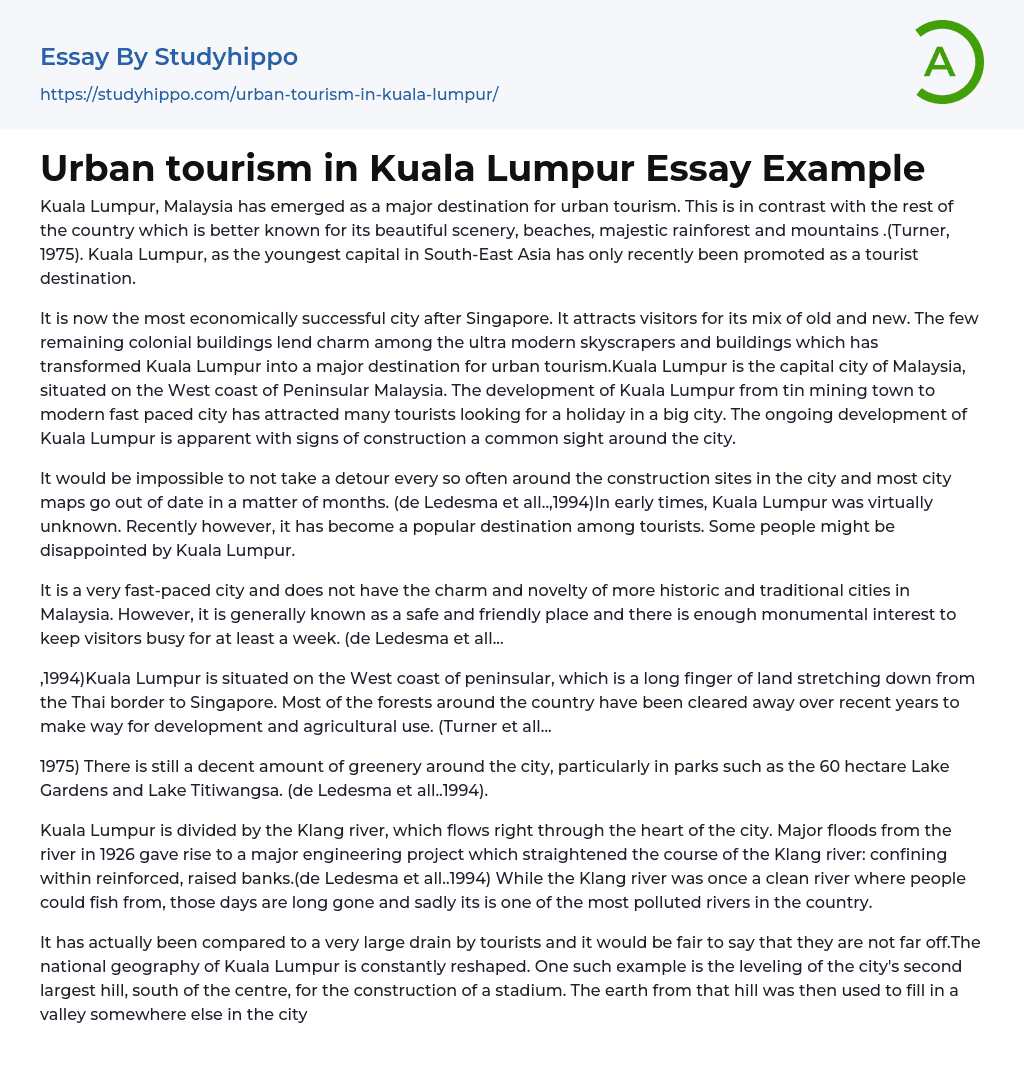Kuala Lumpur, Malaysia has emerged as a major destination for urban tourism. This is in contrast with the rest of the country which is better known for its beautiful scenery, beaches, majestic rainforest and mountains .(Turner, 1975). Kuala Lumpur, as the youngest capital in South-East Asia has only recently been promoted as a tourist destination.
It is now the most economically successful city after Singapore. It attracts visitors for its mix of old and new. The few remaining colonial buildings lend charm among the ultra modern skyscrapers and buildings which has transformed Kuala Lumpur into a major destination for urban tourism.Kuala Lumpur is the capital city of Malaysia, situated on the West coast of Peninsular Malaysia. The development of Kuala Lumpur from tin mining town to modern fast paced city has attracted many
...tourists looking for a holiday in a big city. The ongoing development of Kuala Lumpur is apparent with signs of construction a common sight around the city.
It would be impossible to not take a detour every so often around the construction sites in the city and most city maps go out of date in a matter of months. (de Ledesma et all..,1994)In early times, Kuala Lumpur was virtually unknown. Recently however, it has become a popular destination among tourists. Some people might be disappointed by Kuala Lumpur.
It is a very fast-paced city and does not have the charm and novelty of more historic and traditional cities in Malaysia. However, it is generally known as a safe and friendly place and there is enough monumental interest to keep visitors busy for at least a week. (de Ledesma et all...
,1994)Kuala Lumpur is
situated on the West coast of peninsular, which is a long finger of land stretching down from the Thai border to Singapore. Most of the forests around the country have been cleared away over recent years to make way for development and agricultural use. (Turner et all...
1975) There is still a decent amount of greenery around the city, particularly in parks such as the 60 hectare Lake Gardens and Lake Titiwangsa. (de Ledesma et all..1994).
Kuala Lumpur is divided by the Klang river, which flows right through the heart of the city. Major floods from the river in 1926 gave rise to a major engineering project which straightened the course of the Klang river: confining within reinforced, raised banks.(de Ledesma et all..1994) While the Klang river was once a clean river where people could fish from, those days are long gone and sadly its is one of the most polluted rivers in the country.
It has actually been compared to a very large drain by tourists and it would be fair to say that they are not far off.The national geography of Kuala Lumpur is constantly reshaped. One such example is the leveling of the city's second largest hill, south of the centre, for the construction of a stadium. The earth from that hill was then used to fill in a valley somewhere else in the city.
(de Ledesma et all..,1994)The first settlers in Kuala Lumpur was a group of Chinese prospectors, sent there by the chief of Selangor State in 1857 to search the area for tin, a valuable commodity in those days. Although many of these men died of malaria, a rich deposit of tin
was found and Kuala Lumpur became a place where Chinese labourers came to work. (de Ledesma et all..
.1994)Once British rule took over in the late 19th century, even more Chinese merchants and workers, Malay farmers and Indian labourers from Tamil Nadu arrived in Kuala Lumpur looking for a better life. (de Ledesma et all..
.1994). That explains why Kuala Lumpur today has a unique ethnic mix of Malays, Chinese and Indians. This multicultural balance is evident throughout the city based on the languages spoken and written on signs, the variety of food offered and the number different places of worship available. (de Ledesma et all.
..1994)It is not uncommon to see a sign written in three languages or a Bhuddist temple next to a church or Hindu shrine.As stated above, Kuala Lumpur was first settled by Chinese prospectors looking for tin.
The first Chinese merchants set up two separate secret societies, and as the mainland Chinese were fiercely clannish people, the constant fights for economic spoils hindered their growth. These Chinese workers were unified by Yap Ah Loy, an influential merchant from China. This saw the growth of the Chinese in Kuala Lumpur. (de Ledesma et all..
.1994)His rule however, was ended when the British arrived and took command of Kuala Lumpur. This drew more people to Kuala Lumpur ranging from British investors to Malay farmers. This influx of people saw the transformation of Kuala Lumpur from an inaccessible shantytown to capital of the state. The British resident Frank Swettenham brought in British architects to design buildings suitable for a new capital. By the turn of the century there were about 4000 brick buildings and the population had
increased to about 40000.
(de Ledesma et all...1994)




